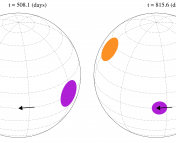Title: Complex Modulation of Rapidly Rotating Young M Dwarfs: Adding Pieces to the Puzzle
Authors: Maximilian N. Günther, David A. Berardo, Elsa Ducrot, Catriona A. Murray, Keivan G. Stassun,
Katalin Olah, L.G. Bouma, Saul Rappaport, Joshua N. Winn, Adina D. Feinstein, Elisabeth C. Matthews, Daniel Sebastian, Benjamin V. Rackham, Bálint Seli, Amaury H. M. J. Triaud, Edward Gillen, Alan M. Levine, Brice-Olivier Demory, Michaël Gillon, Didier Queloz, George R. Ricker, Roland K. Vanderspek, Sara Seager, David W. Latham, Jon M. Jenkins, C. E. Brasseur, Knicole D. Colón, Tansu Daylan, Laetitia Delrez, Michael Fausnaugh, Lionel J. Garcia, Rahul Jayaraman, Emmanuel Jehin, Martti H. Kristiansen, J. M. Diederik Kruijssen, Peter Pihlmann Pedersen, Francisco J. Pozuelos, Joseph E. Rodriguez, Bill Wohler, and Zhuchang Zhan
First Author’s Institutions: Department of Physics, and Kavli Institute for Astrophysics and Space Research, MIT, Cambridge, Massachusetts, USA and European Space Research and Technology Centre (ESTEC), European Space Agency (ESA), Noordwijk, Netherlands
Status: Submitted to AAS journals
What’s in a name?
Naming conventions are not always original. When the ancient Greeks “discovered” the giraffe, they called it a “camel-leopard”. In Chicago, “pizza” is actually soup something else. A “quasar” is named because it could only be described as a quasi-stellar radio object, having no precedent in science. When modern astronomers, then, encountered light curves (the measure of a star’s brightness over time) with multiple repeating wavy undulations, they named it a scallop shell.
What’s special about scallop-shell light curves? A star that steadily produces light will have a flat light curve, as there is no change in brightness. When we do observe a change, however, it’s because something is either blocking the light or happening to the star. A sudden dip can be due to an exo-planet transiting in front of the star, and a sinusoidal dim can be caused by the star pulsating or star spots rotating around on its surface. All three types of these dimming events occur with consistent repetition.

Strange light curves define a new type of object
Complex rotators (a more generalized term that includes the scallop-shell from the first paragraph) do something completely different. When each cycle of repetition in a light curve is stacked on top of one another (called a phased light curve), the features of the light curve that persist line up exactly. This implies some cyclical effect or motion. However, the repeating patterns in complex rotators are bizarre, unusually sharp dimming or swelling in brightness. For an example see Figure 1. While a spotted star will usually have a gentle rise and fall to it’s phased lightcurve, complex rotators will be full of bumpy scallop like ridges, or thrilling crests and valleys. The nested patterns appear steady for months, a strange stability.
Since they have only recently been described, complex rotators don’t have an accepted explanation. We do know that they are usually small, young M dwarf stars—only a few tens of million years old—that are rapidly spinning (2 – 20 hour period). Sudden dimming has been seen in other systems where discs or clouds of material obscure the star. Those systems have sudden quick changes in brightness that are usually inconsistent, almost chaotic, and never with the stability seen in complex rotators.
Potential explanations
Today’s paper attempts to summarize the existing theories. The two most compelling possibilities are both illustrated in Figure 2. Option 1 imagines that a cloud of material orbits the star such that it completes an orbit once per stellar rotation. The material blocks the light and causes the dipping features from our perspective. If there are starspots on the star they need to rotate at the same rate as the clouds to explain the stability of the features in the phased light curve, which would require a precise orbit for the clouds. Therefore the clouds of material would need to be orbiting at a distance that they co-rotating along with the surface of the star.

Option 2 does away with clumpy clouds, and instead includes a dusty disk misaligned from the rotation of the star. With star spots rotating on the surface and a misaligned disk, if the observer is in the right position the star spots will occasionally slip behind the disk during the cycle of rotation. If the disk isn’t misaligned from rotation, the change in brightness would be smooth. Here, only the rotation of the star and the starspots would drive the sharp features in the phased light curve, and the disk can be at any distance as long as it blocks starspots from our perspective.
Other theories include dust or gas on the surface, spots with stellar pulsation, or accretion on to the stellar surface, but they all struggle to explain the narrow features and strict repetition.
Chipping away at the shell
The authors also add a few more pieces to the puzzle. They followed up on a few objects a year after they were originally observed. They found that the general shape and the larger features in the light curve remained. This means that the physical model now needs to explain stability on the order of a year, and not just months as previously observed. A little more challenging for the dust cloud theory, but still plausible for both.
Finally, they used their newer observations to check to see if there was a color dependence to the light curves. By using multiple wavelengths of light, they saw that certain features had different sized dips or gains in brightness in different colors. This is a sign that what is causing the change in brightness is partly color dependent, which can be a big clue to the makeup of the blocking material. Unfortunately, both leading theories could have some color dependence, so no help there either!
Coming full circle
Even with these new clues, the authors don’t decide on one theory over the other, which is reasonable considering both can still be justified with the current evidence. We need more observations, including some from TESS, to really confirm what complex rotators are.
I find it so compelling that these stars spin on a timescale approachable to humans. In the time it takes to watch a movie, you could watch as clouds whip across a stellar disk (“I love this part”), or star spots dip behind a disk of debris (“There it goes, oh here comes another!”). It would be a cosmic light show that once carried the name of a simple shell, an astronomical spectacle that we could enjoy during a human attention span.
Featured Image Credit: NASA, ESA, AURA/Caltech, Palomar Observatory and Naples Sea Shell Company
Edited by: Kayla Kornoelje, Briley Lewis





Could precession play a role?